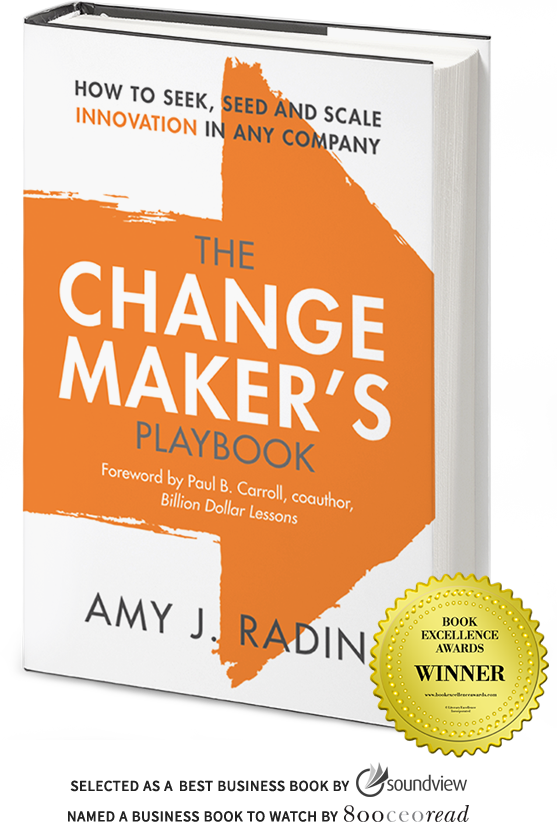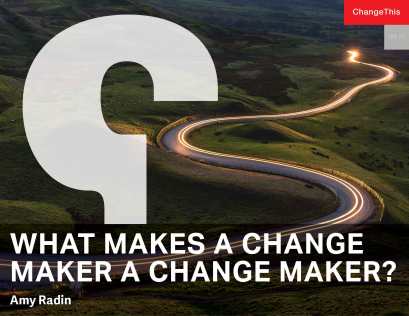Amy Radin, an innovation, digital transformation and marketing expert, recently published a second printing of Book Excellence Award Winner, The Change Maker’s Playbook: How to Seek, Seed and Scale Innovation in Any Company, where she examines thoroughly innovation through various angles, from finding, nurturing and scaling market-leading innovations. She kindly accepted to discuss with us a few questions.
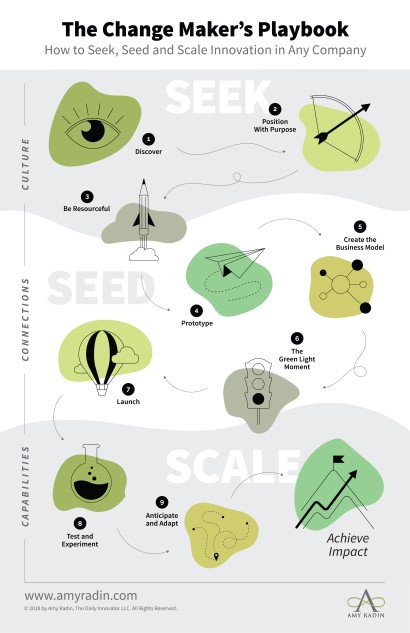
1) Hi Amy, can you tell us about your experience, and how you came up with the idea of a playbook about innovation? What was the problem you were trying to solve with the book? How did you manage to shape an original identity for the book, considering there are several playbooks on innovation on the market?
Innovation is easy to talk about but it’s hard to create tangible results that really matter. Having been an innovation operating executive in a very demanding, bottom-line oriented sector, I wanted to help others accomplish their visions, by sharing my expertise as well as that of the nearly 50 other change makers who contributed their stories to the Playbook. Most books on the topic come from academics and consultants. What’s different about the Change Maker’s Playbook is that 100% of the recommendations come from people who were in the innovation “hot seat” under pressure to deliver results, not just theories.
2) You wrote “This book is for leaders who want to solve unmet market needs”. Does it mean that the target readers of The Change Maker’s Playbook are first of all innovation managers, new product marketers, CEOs? Or also employees like corporate innovators / intrapreneurs, and, outside the corporation, entrepreneurs? In other words, what is your definition of a change maker?
A change maker is anyone who wants to solve unmet market needs and move beyond just having ideas to pursuing with commitment and purpose the creation of new forms of value of benefit to all stakeholders to their solution. And yes, change makers are not just founders in the startup world – they are present in corporate environments as well. While change makers need sponsorship – and in the corporate world that will best come from the CEO – the mindset and willingness of the change maker should, ideally, live throughout the organization.
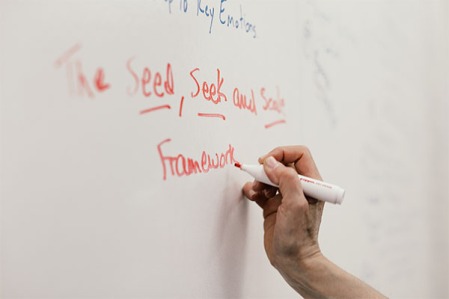
3) You marry closely change makers with innovation, and explains how “change making is not an option”; do you see differences / commonalities with change management and transformation plans, mainly focused on digital transformation (tools, culture, organization , and process) that corporations have engaged for the past years?
Note these contrasting dictionary definitions:
- Management: “The process of dealing with or controlling things or people”;
- Making: forming (something) by putting parts together or combining substances; constructing; creating.
We are living in a dynamic world with an unprecedented need for change. “Management” as a way of sustaining viable businesses is outmoded. We must all be creating the future through our daily actions, including challenging the status quo.
I define “Innovation” as the creation of viable new offerings that solve the real needs of real people. Needs are both rational and emotional. Change makers are, therefore, innovators. The word “innovation” is so misunderstood that in writing the book, and especially in creating the title, I sought language that would stand on its own, motivate and inspire, and cause change makers to step up.
4) Jeff Bezos shared that innovators have both to be “stubborn (in the vision) and flexible (in the details)”. Would you say that in the Seek stage, where innovators “collect thoughtful customers insights, observe behaviors, listen, practice discovery as a co-development with users, and accumulate learnings”, they have to be utmost flexible about their original idea, and not to build “the perfect product only for themselves”, but “break away from easily copied products”? What are your advice to be a good listener, with an open mind?
To be a good listener, start by recognizing that we all listen with the biases we bring with us – what we already know, believe and have experienced. Acknowledge your biases and work to not have them become filters.
Talk less, listen more, and when you do speak, ask questions. One of my favorite lines of questioning when I am trying to learn from a potential user or a founder is to ask things like, “How did you figure out what do to?” “What did you do/think?” “And then what” – keep probing and peeling back the onion – but above all, let the other person speak and tell their story.
Listen with your eyes, not just your ears. We can learn a lot from people’s behavior, and often people cannot express themselves with words, but they express a lot in actions, frustrations, body language. Watch.

5) The second stage, Seed, stresses on quick iterative concept validation, and engaging users in prototypes. Would you confirm that, to achieve innovation in short cycles, team togetherness is paramount, seeking to look like a perfectly well-oiled mechanism? What do you think of this idea that an innovation team is like a business unit: all are working towards a common goal, and at the same time, everyone has its own plan?
The prototyping process as with the entire Seek, Seed, Scale framework, demands collaboration from people who bring different skills and perspectives, but have a passionate commitment to solving the problem you have set out to solve. “Plans” especially at the prototyping stage are going to be reset potentially even daily. I love how startup teams often have frequent, very short stand-up meetings – where the team comes together, shares yesterday’s or the week’s results, and reformulates their individual plans on the fly in response.
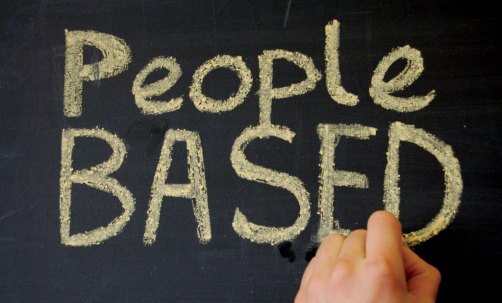
6) We have designed a Scale-up canvas to support the work of our intrapreneurs, and internal startup. It includes updating the value proposition to cross the chasm, industrializing the product and processes (marketing, sales, channels, hiring…), grooming the human organization, and transitioning to a business unit management system. What is the main challenge in this Scale phase? Often underestimated, the human factor can be decisive when you move from a team of 10 to 200 people in a few months: what is your advice on preserving and maturing the culture, “shifting the mindsets” accurately for the new trajectory?
The challenge is how do you get from a very fast, informal way of operating that is so helpful to generating innovations, to the more robust processes and complex organization structure, vendor relationships, etc. that are needed to drive volume, deliver with predictable quality, and adhere to regulations – while not creating a bureaucracy and losing the passion, energy and excitement that allowed the idea to become a reality as a new offering?
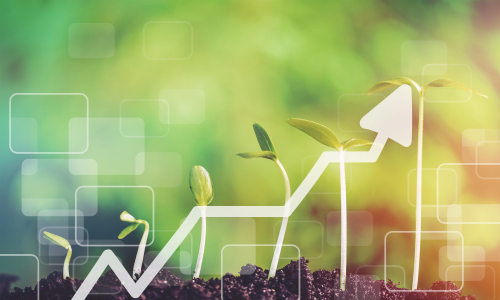
Sometimes the people who do best at the early stages are not the same people to deliver at scale – starting with the leader who must recognize if they are the right person to lead the next phase. They must ensure that as the team expands and is held accountable for financial returns and delivery to customers that the strength of the culture – and the team’s accumulated knowledge and experience – is sustained.
This transition is easier when the team has worked all along to establish a culture where diverse people and viewpoints are welcome, and where people outside the team are aware of and excited about its work. If this is happening the best people will want to join the team and sustain what is special about it. If the transition from Seed to Scale is approached as a simple hand-off there will be more risk on all fronts.
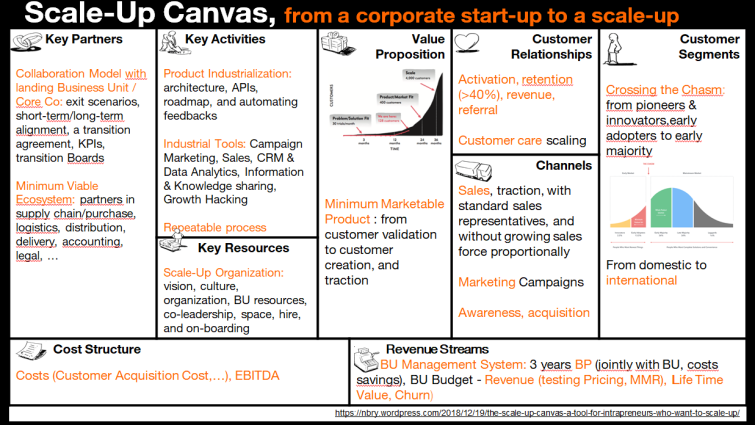
7) What kind of metrics would you recommend to measure innovation impact?
Avoid imposing the traditional metrics applied to a mature business to assess innovation impact of a fragile, unproven concept. Doing this can kill even high potential concepts.
The right metrics will vary depending upon what phase of development you are in. Early on, do the analytic work to translate your qualitative understanding of who the customer is into a rough market sizing. Then do what I call “the one percent test.” Take one percent of the market size and see how you feel about it. On gut, is it worth pursuing?
Later as you get into even limited in-market testing, focus on identifying the customer and user behaviors that will drive your business model. Work to measure what those behaviors are in the different tests you may be conducting, and how you can affect behavior – or where what you are learning is feedback that perhaps your business model needs refining.
Metrics that are focused on results – outputs – will come later. And when they are appropriate, be clear on what low-volume results look like versus what you expect to achieve at scale.

8) Following work-at-home development, how can companies a culture of innovation with a remote workforce?
Innovation is so dependent upon collaboration, but also the “water cooler” talk – the informal conversations and interactions that happen serendipitously outside scheduled meetings. I worry about these being lost not just because of remote location per se, but the pressures people are experiencing as there are no boundaries between personal and work life in this new environment.
There is a lot of focus now on work from home productivity which may be ignoring how much innovation is progressed when we are not focused on processing required, short term tasks. Innovation is messy, it does not happen through linear execution of project plans.
Companies should reinforce – through communications, recognition, and the actions of team leaders – that time spent reading, exploring, networking, learning beyond the bounds of what is required for the short term – is valued. They must also recognize that while many people are happy to give up commuting, many are also struggling with childcare, eldercare and other personal challenges that have all come down on them as the pandemic has disrupted people’s life management ‘systems.’ There is a lot of stress and fear, and both of these emotional states are innovation inhibitors.

